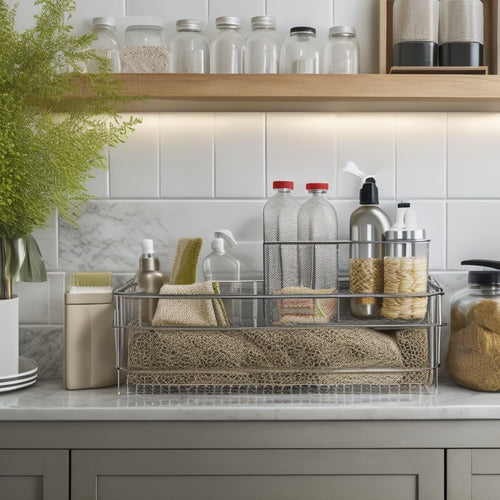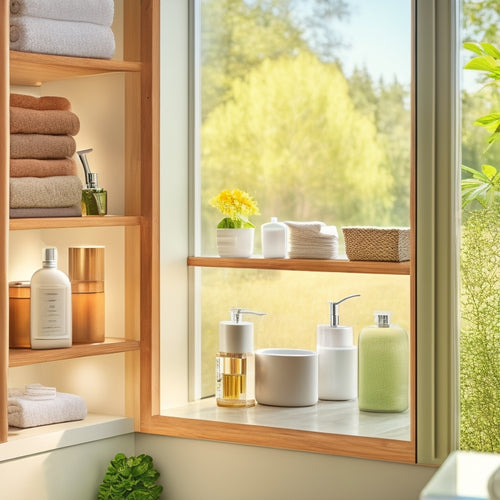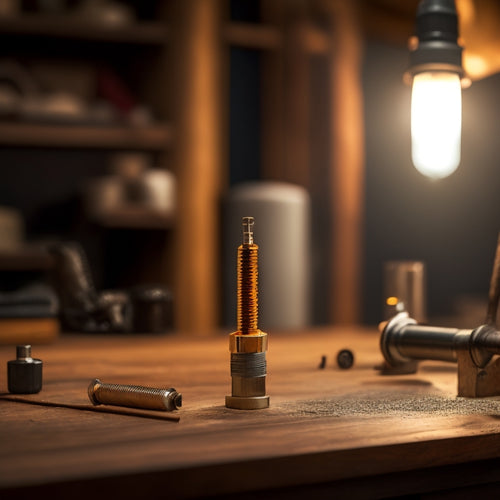
What Are the Essentials for a Functional Toilet Setup
Share
When setting up a functional toilet, you'll need to cover the essentials. Start with a comfortable and hygienic toilet bowl and seat, considering factors like material, seat design, and dimensions. Guarantee a reliable water supply connection with proper pressure and leak prevention. Then, focus on the flushing mechanism, including the flapper valve, fill valve, and siphon jet. Don't forget about venting and drainage, which prevent clogs, overflows, and odors. Finally, think about hygienic accessories like soft seat covers and regular maintenance to prevent clogs, leaks, and breakdowns - and that's just the beginning of creating a truly functional toilet setup.
Key Takeaways
- A functional toilet setup requires a proper water supply connection with ideal pressure and secure fittings to prevent leaks and ensure efficient flushing.
- Durable and easy-to-clean materials, such as porcelain or vitreous china, are essential for the toilet bowl and seat to maintain hygiene and comfort.
- A reliable flushing mechanism depends on essential parts like the flapper valve, fill valve, and siphon jet, which must be properly installed and maintained.
- A well-designed venting and drainage system with proper vent stack design, pressure equalization, and drainage capacity is critical for preventing clogs, overflows, and odors.
- Regular maintenance, including clog prevention, tank cleaning, and leak inspections, is necessary to ensure the toilet operates smoothly and prevent costly repairs.
Toilet Bowl and Seat Requirements
When selecting a toilet bowl and seat, evaluating factors that impact comfort, hygiene, and functionality is vital. You'll want to choose a toilet bowl material that's durable, easy to clean, and resistant to scratches and stains. Popular options include porcelain, vitreous china, and ceramic. Each has its pros and cons, so weigh them carefully before making a decision.
Seat ergonomics are also important, as they affect your overall comfort and hygiene. Look for a seat with a contoured design that fits your body shape. You may also want to think about a heated seat or one with advanced features like bidet functionality or self-cleaning technology.
Don't forget to check the seat's height and width to make sure it's suitable for your needs. Ultimately, your toilet bowl and seat should provide a comfortable, hygienic, and functional experience.
Proper Water Supply Connection
A reliable water supply connection is essential to your toilet's overall performance, and it's important to get it right from the start. You don't want to be stuck with a toilet that can't perform its main function – flushing waste away efficiently.
To avoid this, guarantee your water supply connection provides sufficient water pressure, usually between 30 and 80 pounds per square inch (psi). This pressure range allows for a strong, consistent flow of water to fill the tank and bowl.
When it comes to connection types, you'll typically encounter two options: flexible hoses or rigid copper pipes. Flexible hoses are more common and easier to install, but they're prone to damage and may need to be replaced more frequently.
Rigid copper pipes, on the other hand, are more durable and less likely to leak, but they can be more challenging to install. Regardless of the connection type, make certain to check for leaks and tighten any loose fittings to prevent water waste and damage to surrounding areas.
Essential Flushing Mechanism Parts
With a reliable water supply connection in place, you can now focus on the flushing mechanism that makes your toilet functional. This is where the magic happens, and you get to experience the thrill of watching your, ahem, "business" disappear down the drain. But seriously, a well-designed flushing mechanism is vital for a hygienic and efficient toilet experience.
The flushing mechanism consists of several essential parts, which we've broken down for you in the table below:
| Part | Function | Importance |
|---|---|---|
| Flapper or Flap Valve | Controls water flow from tank to bowl | High |
| Fill Valve | Refills tank with water | High |
| Float | Regulates water level in tank | Medium |
| Siphon Jet or Flush Valve | Creates suction to flush waste | High |
| Overflow Tube | Prevents tank overflow | Medium |
When it comes to flushing technology, tank capacity is a significant factor. A larger tank capacity means more water is available for each flush, resulting in a more effective flush. However, it also increases water consumption. You'll need to strike a balance between flushing power and water efficiency.
Venting and Drainage System
The venting and drainage system is the unsung hero of your toilet's overall functionality, quietly working behind the scenes to guarantee a smooth, odorless, and mess-free experience. You mightn't give it much thought, but trust us, it's the real MVP (Most Important Plumber).
Without a proper venting system, you'd be stuck with a toilet that's constantly clogging, overflowing, or – worst of all – emitting a stench that'd clear out a room.
When it comes to toilet venting, you need a system that allows air to enter the drain pipes and equalize pressure. This guarantees that water flows freely and doesn't create a vacuum that'd suck everything (and everyone) in.
A well-designed venting system will have a vent stack that runs from the sewer line to the roof, providing a clear path for gases to escape.
As for drainage systems, you want one that's designed to handle the volume of water and waste you're flushing down the toilet. Look for systems with the right-sized pipes, proper slope, and a trap that prevents sewer gases from seeping back into your bathroom.
With a solid venting and drainage system, you can bid farewell to those dreaded toilet troubles and hello to a stress-free bathroom experience.
Hygienic and Comfortable Accessories
You'll want to contemplate adding soft seat covers to your toilet setup, which provide an extra layer of comfort and hygiene during use.
Gentle hand sanitizers are also a must-have, ensuring you can maintain cleanliness without drying out your skin.
Soft Seat Covers
Soft seat covers offer a hygienic and comfortable solution for your toilet setup.
You're probably thinking, "Why do I need a soft seat cover?" Well, let's face it, a toilet seat can be a breeding ground for bacteria and germs. A soft seat cover provides an extra layer of protection between you and the toilet seat, making it a must-have for any functional toilet setup.
When choosing a soft seat cover, consider the following:
-
Eco-friendly materials: Opt for covers made from eco-friendly materials that are gentle on the environment and your behind.
-
Installation tips: Make certain to follow the manufacturer's installation instructions to guarantee a secure fit and prevent any accidents.
-
Maintenance routine: Develop a regular cleaning routine to keep your soft seat cover fresh and hygienic.
Gentle Hand Sanitizer
Hand sanitizer stations strategically placed near your toilet setup can be a breakthrough in maintaining a hygienic environment.
You'll appreciate the convenience of having a gentle hand sanitizer nearby, especially after, ahem, taking care of business. When selecting a sanitizer, consider the types that cater to your user preferences. Do you prefer foam, gel, or spray? Are you looking for a fragrance-free or moisturizing option?
Some popular sanitizer types include ethanol-based, isopropanol-based, and benzalkonium chloride-based formulas. Ethanol-based sanitizers are effective against most bacteria and viruses, while isopropanol-based ones are gentler on skin. Benzalkonium chloride-based sanitizers offer a non-alcohol alternative.
When choosing a sanitizer, also think about the dispenser type. Do you prefer a wall-mounted, freestanding, or touchless unit?
Consider the size, material, and ease of refilling or replacing the sanitizer cartridges. By selecting a gentle hand sanitizer that meets your needs, you'll create a comfortable and hygienic toilet setup that's a refreshing change – or should we say, a splash of cleanliness?
Regular Maintenance and Repairs
Inside your toilet's cramped quarters, a multitude of moving parts and connections work in tandem to guarantee a smooth, trouble-free experience.
But don't be fooled – all these intricate components require regular maintenance to prevent breakdowns and costly repairs.
You'll want to check in on your toilet regularly to verify it's running like a well-oiled machine.
Here's a quick rundown of what you should focus on:
-
Clog prevention: Make sure to only flush biodegradable waste and avoid overloading the toilet with too much toilet paper or other materials.
-
Tank cleaning: Every 3-6 months, give your tank a good scrub to remove mineral deposits and sediment buildup that can affect flush performance.
-
Leak checks: Inspect the toilet's flapper, fill valve, and wax ring for any signs of leaks or wear and tear.
Frequently Asked Questions
Can a Toilet Be Installed on a Concrete Floor?
You can install a toilet on a concrete floor, but you'll need to guarantee the floor's level, clean, and dry, and use a toilet flange specifically designed for concrete flooring to secure the toilet installation.
Are Toilet Seats Required to Be a Specific Color?
When you're stuck between a rock and a hard place, you'll find that toilet seats aren't required to be a specific color, but you should consider toilet color psychology, as it affects ambiance; plus, toilet seat materials like ceramic, plastic, or wood impact durability and maintenance.
Can I Use a Toilet in a Room Without a Window?
You can definitely use a toilet in a room without a window, but you'll need to get creative with ventilation solutions, like fans or exhaust systems, to tackle odor management and keep the air fresh and, ahem, non-toxic.
How Often Should Toilet Handles Be Replaced?
You're the expert of your throne, but when's the last time you gave your toilet handle some TLC? For ideal toilet maintenance, swap it out every 5-7 years, depending on handle durability and usage - don't let a worn-out handle leave you feeling flushed!
Are Wall-Mounted Toilets More Difficult to Install?
You're wondering if wall-mounted toilets are more difficult to install? Well, let's flush out the truth: yes, they can be, thanks to installation challenges like ensuring proper wall support, but with the right tools and a solid plan, you'll be sitting pretty in no time!
Conclusion
You've finally assembled the perfect toilet setup, complete with a comfortable seat and efficient flushing mechanism. But don't think you're off the hook that easily - without regular maintenance and repairs, your porcelain throne can quickly become a breeding ground for bacteria and a nightmare to clean. So, go ahead and pat yourself on the back for a job well done, but don't get too comfortable - your toilet still needs you.
Related Posts
-

Under-Sink Storage Solutions for Urban Living
Under-sink areas in urban apartments can change from cluttered voids into efficient storage havens with smart solutio...
-

Modular Storage for Bathroom Decluttering
Modular storage is your solution for effective bathroom decluttering. It maximizes every inch of space, allowing cust...
-

Cabinet Drill Template: Warranty Included for Satisfaction
A cabinet drill template with a warranty included provides DIY enthusiasts and professionals with a reliable and prec...


